Visit to Two Big Belgian Companies (No.14)
The other day, I enjoyed playing golf for the first time since my arrival to Belgium. It was the first time in 6 months for me to get out on the course. Moving your body in the open air in spring-like weather is invigorating. When I went to the golf course, I discovered that many Belgians enjoy playing golf, which was a little surprising for me. Somehow it seems I had the prejudice that Belgians did not play golf. Come to think of it, according to an article in a local newspaper a few months ago, the number of golfers is increasing in Belgium and the active role of golf player Mr Nicolas Colsaerts, the only Belgian in the high position of the world ranking for professional golf, has a positive influence. I looked up that 56.000 (end of 2011) people are registered as golf club member in Belgium. That means the 6th position after soccer, tennis, gymnastics, basketball and horse-riding. Furthermore, when comparing the number of golfers of the Dutch-speaking area and the French-speaking area, the ratio is almost 6:4, so the Dutch-speaking area is dominant. Of the 22.576 golf club members in the French-speaking area, the male to female ratio is 2:1, which is a high percentage of female golfers compared with Japan. As for age composition, the ratio of young people under 25 years old is only 14%, which is, compared to the 46% of golfers over the age of 55, less than one-third. In Belgium, golf seems to be seen as a “sports for rich old people”. However, thanks to the worldwide success of Mr. Colsaerts (a long hitter with average driving distance of 290 m) and the fact that golf will be an official sport at the Rio 2016 Olympic Games, perhaps the day for the “democratization” of golf in Belgium is near.
< Solvay Group and NV Bekaert SA >
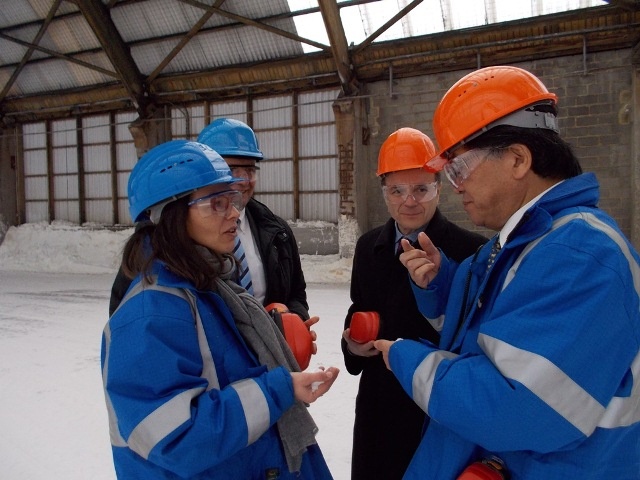 Last month I visited the Jemeppe factory of Solvay, the biggest company in the chemical industry in Belgium. As I already introduced the founder, Mr. Ernest Solvay, in the previous Ambassador’s Chat in detail, I will not repeat it, but he is the legendary industrialist who founded the “Solvay group” of today which celebrates this year its 150th anniversary. Jemeppe is located 60 km south of Brussels, east of Charleroi, which is the fifth largest city of Belgium. This factory (currently 483 employees) was opened 116 years ago in 1897. In a rural village off the beaten track, there is a huge plant facility that produces mainly about 500.000 ton per year of a chemical product called PVC, which is widely used as raw material for plastics (it looks like white powder). PVC raw materials are ethylene and rock salt and electric power is necessary for electrolysis. At first sight the manufacturing process seems simple, but the scale of the plant is the largest in Europe. During the production, sodium bicarbonate and caustic soda are retrieved as well. In total, Solvay Group has 111 factories (29.100 employees) worldwide and annual total sales amount to 12.4 billion euro. As a chemical company, it is a big company ranking in the world’s top 10. “NIPPON SOLVAY K.K” specialized in import and sales was founded in 1987 in Japan and the office is in Toranomon, Tokyo. Total sales in Japan amount to approximately 437 million euro. Until 3 years ago, there was also “Solvay Seiyaku K K” in Japan, but Solvay Headquarters sold off its pharmaceuticals division to the American Abbott Laboratories, so Solvay Pharmaceuticals does not exist anymore. Last month I visited the Jemeppe factory of Solvay, the biggest company in the chemical industry in Belgium. As I already introduced the founder, Mr. Ernest Solvay, in the previous Ambassador’s Chat in detail, I will not repeat it, but he is the legendary industrialist who founded the “Solvay group” of today which celebrates this year its 150th anniversary. Jemeppe is located 60 km south of Brussels, east of Charleroi, which is the fifth largest city of Belgium. This factory (currently 483 employees) was opened 116 years ago in 1897. In a rural village off the beaten track, there is a huge plant facility that produces mainly about 500.000 ton per year of a chemical product called PVC, which is widely used as raw material for plastics (it looks like white powder). PVC raw materials are ethylene and rock salt and electric power is necessary for electrolysis. At first sight the manufacturing process seems simple, but the scale of the plant is the largest in Europe. During the production, sodium bicarbonate and caustic soda are retrieved as well. In total, Solvay Group has 111 factories (29.100 employees) worldwide and annual total sales amount to 12.4 billion euro. As a chemical company, it is a big company ranking in the world’s top 10. “NIPPON SOLVAY K.K” specialized in import and sales was founded in 1987 in Japan and the office is in Toranomon, Tokyo. Total sales in Japan amount to approximately 437 million euro. Until 3 years ago, there was also “Solvay Seiyaku K K” in Japan, but Solvay Headquarters sold off its pharmaceuticals division to the American Abbott Laboratories, so Solvay Pharmaceuticals does not exist anymore.
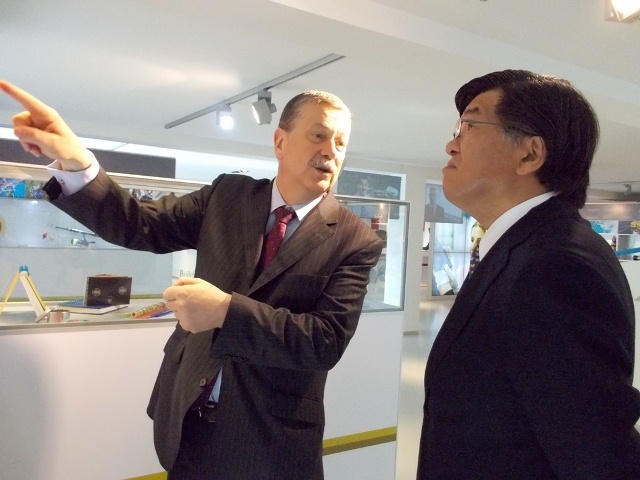 Last week, I visited also NV Bekaert SA, another representative company of Belgium. As already introduced in Ambassador’s Chat No. 9, this company started its business more than 130 years ago with a small factory making barbed wire and now dominates the world market for iron wire. This company currently has business relationships with over 120 countries worldwide and employs 27.000 workers in its 100 factories. Last year’s total sales amounted to 4.4 billion euro, of which 38% were sales in Latin America and 23% in Asia. The iron wire produced by Bekaert is used in all areas, but the most important area is automobile-related (tires, springs, etc.), accounting for 34% of the total sales. NV Bekaert SA has a very close business relationship with Japan. For example, they import steel from Nippon Steel Corporation and Kobe Steel, Ltd in large quantities and they sell the products to tire manufacturer Bridgestone. The founding family (220 people) owning nearly 40% of all shares, NV Bekaert SA has kept the character of a family business, but both Baron Buysse, Chairman of the Board and Bert De Graeve, CEO, whom I met, are not of the family. Today, the management of the company seems to be out of the hands of the Bekaert family. Last week, I visited also NV Bekaert SA, another representative company of Belgium. As already introduced in Ambassador’s Chat No. 9, this company started its business more than 130 years ago with a small factory making barbed wire and now dominates the world market for iron wire. This company currently has business relationships with over 120 countries worldwide and employs 27.000 workers in its 100 factories. Last year’s total sales amounted to 4.4 billion euro, of which 38% were sales in Latin America and 23% in Asia. The iron wire produced by Bekaert is used in all areas, but the most important area is automobile-related (tires, springs, etc.), accounting for 34% of the total sales. NV Bekaert SA has a very close business relationship with Japan. For example, they import steel from Nippon Steel Corporation and Kobe Steel, Ltd in large quantities and they sell the products to tire manufacturer Bridgestone. The founding family (220 people) owning nearly 40% of all shares, NV Bekaert SA has kept the character of a family business, but both Baron Buysse, Chairman of the Board and Bert De Graeve, CEO, whom I met, are not of the family. Today, the management of the company seems to be out of the hands of the Bekaert family.
< The Mayor of Ghent and the President of VOKA >
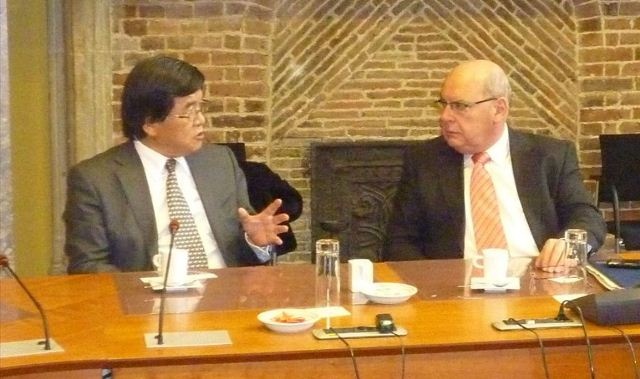 One week ago I visited Ghent, the third largest city in Belgium (245.000 inhabitants) situated 60 km west of Brussels and paid a courtesy call to Mayor Daniel Termont. Ghent is known as a historical and cultural city with 3.1 million visitors per year (850.000 hotel guests). There is a very famous painting (polyptych) called “The Mystic Lamb” painted by the brothers Van Eyck, in the St.-Baafskathedraal in the centre of town. However, when we met, Mayor Termont emphasized Ghent as a modern industrial town and a port city. He also put the emphasis on Ghent as a university town (67.000 students), home to the University of Ghent which is said to be the best in Europe. The city of Ghent that flourished from the Middle Ages through modern times thanks to the textile industry, is now Belgium’s leading industrial city, such as in the steel industry (Arcelor Mittal), automobile (Volvo, Honda) and biotechnological industry. The expansion of the port is also progressing. According to Mr Daan Schalck, CEO of the Port of Ghent, who attended the meeting, the freight volume handled currently is over 50 million tons per year and there are plans to equip the port facilities in such a way that large ships of more than 100.000 tons can enter into the port in a few years’ time. In relation to Japan, Ghent and Kanazawa have been sister cities since 1971 and had various exchanges. At the end of our meeting, Mayor Termont stated that he strongly hoped that Japanese companies would advance into Ghent. One week ago I visited Ghent, the third largest city in Belgium (245.000 inhabitants) situated 60 km west of Brussels and paid a courtesy call to Mayor Daniel Termont. Ghent is known as a historical and cultural city with 3.1 million visitors per year (850.000 hotel guests). There is a very famous painting (polyptych) called “The Mystic Lamb” painted by the brothers Van Eyck, in the St.-Baafskathedraal in the centre of town. However, when we met, Mayor Termont emphasized Ghent as a modern industrial town and a port city. He also put the emphasis on Ghent as a university town (67.000 students), home to the University of Ghent which is said to be the best in Europe. The city of Ghent that flourished from the Middle Ages through modern times thanks to the textile industry, is now Belgium’s leading industrial city, such as in the steel industry (Arcelor Mittal), automobile (Volvo, Honda) and biotechnological industry. The expansion of the port is also progressing. According to Mr Daan Schalck, CEO of the Port of Ghent, who attended the meeting, the freight volume handled currently is over 50 million tons per year and there are plans to equip the port facilities in such a way that large ships of more than 100.000 tons can enter into the port in a few years’ time. In relation to Japan, Ghent and Kanazawa have been sister cities since 1971 and had various exchanges. At the end of our meeting, Mayor Termont stated that he strongly hoped that Japanese companies would advance into Ghent.
With regard to the Flemish region, I met with Michel Delbaere, President of VOKA (Flanders' Chamber of Commerce and Industry) and exchanged opinions on the current international economic climate, the Japan-Belgium relations and the EPA negotiations between Japan and the EU. VOKA was founded in 2004 as an alliance to unite the various industry groups in Flanders and consists of 18.000 member companies. These member companies account for two thirds of employment and production by the private sector in Flanders, which makes VOKA one of the biggest industry associations. President Delbaere himself comes from the food industry and had a business relationship with “Kagome” in Japan. Although he is in favour of the Japan-EU EPA, he also stated that the Japanese market is a difficult market to enter for foreign companies. As many Japanese companies are active in Flanders, I would like to deepen the collaboration with VOKA.
< Company Visit No. 8 – Two Japanese Companies >
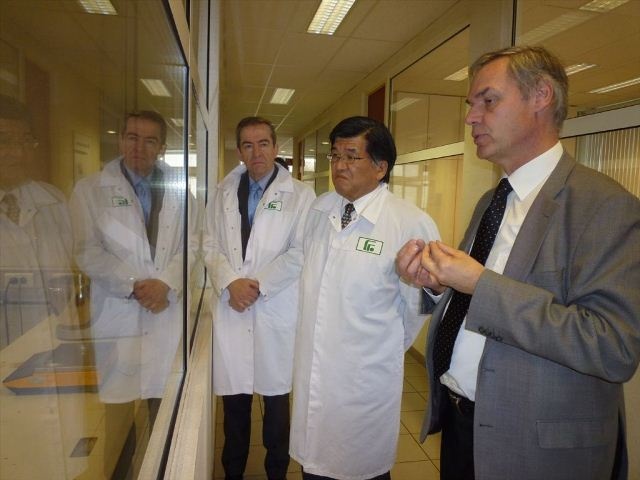 On the occasion of my visit to Ghent, I paid a visit to Fuji Oil Europe, one of the Japanese companies operating in the area. This company started its business as a joint venture with a local company in 1992, but the company name was changed to its current name in 2001 as a Japanese company with 100% owned capital. Fuji Oil Europe mainly processes and produces oil and fats to be used as raw material for chocolate and the current number of employees is 110. Total sales amount to 100 million euro and they are expanding their sales routes within Europe, of course, but also as far as Siberia. The parent company “Fuji Oil” in Japan is headquartered in Osaka and was founded in 1950. Today, Fuji Oil has 25 factories worldwide and has grown into a market leader with total sales of 1.89 billion euro. Managing Director of Fuji Oil Europe is Mr. Bernard Cleenewerck, who is the first Belgian Managing Director in the company. He is young and motivated and I look forward to future business expansion. On the occasion of my visit to Ghent, I paid a visit to Fuji Oil Europe, one of the Japanese companies operating in the area. This company started its business as a joint venture with a local company in 1992, but the company name was changed to its current name in 2001 as a Japanese company with 100% owned capital. Fuji Oil Europe mainly processes and produces oil and fats to be used as raw material for chocolate and the current number of employees is 110. Total sales amount to 100 million euro and they are expanding their sales routes within Europe, of course, but also as far as Siberia. The parent company “Fuji Oil” in Japan is headquartered in Osaka and was founded in 1950. Today, Fuji Oil has 25 factories worldwide and has grown into a market leader with total sales of 1.89 billion euro. Managing Director of Fuji Oil Europe is Mr. Bernard Cleenewerck, who is the first Belgian Managing Director in the company. He is young and motivated and I look forward to future business expansion.
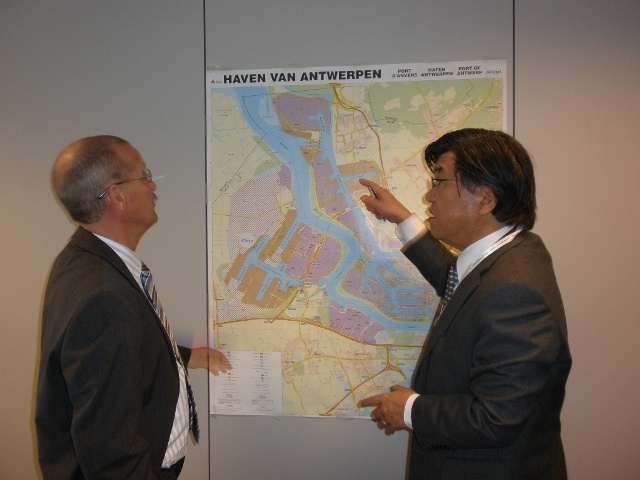 The next day, I visited the port of Antwerp for a company visit to ITC Rubis (35 employees) which started its business two and a half years ago. Japanese companies affiliated with Mitsui & Co invested 50% in this company that is a storage terminal for petroleum products, liquid gas and chemicals. It has a vast site in the back of the port of Antwerp where more than 20 large storage tanks are lined up along the pier. Part of the facilities is still under construction and there are plans to expand the storage tanks further to the adjacent vacant lot in the future. The port of Antwerp is the second biggest storage hub in Europe after the port of Rotterdam in the Netherlands and the 14 major storage terminal companies including the VOPAK (Netherlands), which is unrivalled worldwide, are integrating. The Antwerp Port Authority is constructing a new port gate accessible to large ships to be completed in 2016, so the functionality will be even further enhanced. What is interesting is that it is necessary to get the permits to build new facilities from the authorities of both the province of Antwerp and East Flanders, because the geographic location of the port of Antwerp extends to both provinces. As the standards and judgements for the permits with regard to the impact on the environment seem to be slightly different between both provinces, I think about the companies’ hardships. The next day, I visited the port of Antwerp for a company visit to ITC Rubis (35 employees) which started its business two and a half years ago. Japanese companies affiliated with Mitsui & Co invested 50% in this company that is a storage terminal for petroleum products, liquid gas and chemicals. It has a vast site in the back of the port of Antwerp where more than 20 large storage tanks are lined up along the pier. Part of the facilities is still under construction and there are plans to expand the storage tanks further to the adjacent vacant lot in the future. The port of Antwerp is the second biggest storage hub in Europe after the port of Rotterdam in the Netherlands and the 14 major storage terminal companies including the VOPAK (Netherlands), which is unrivalled worldwide, are integrating. The Antwerp Port Authority is constructing a new port gate accessible to large ships to be completed in 2016, so the functionality will be even further enhanced. What is interesting is that it is necessary to get the permits to build new facilities from the authorities of both the province of Antwerp and East Flanders, because the geographic location of the port of Antwerp extends to both provinces. As the standards and judgements for the permits with regard to the impact on the environment seem to be slightly different between both provinces, I think about the companies’ hardships.
< 2 Graduation Ceremonies and 2 School Entrance Ceremonies >
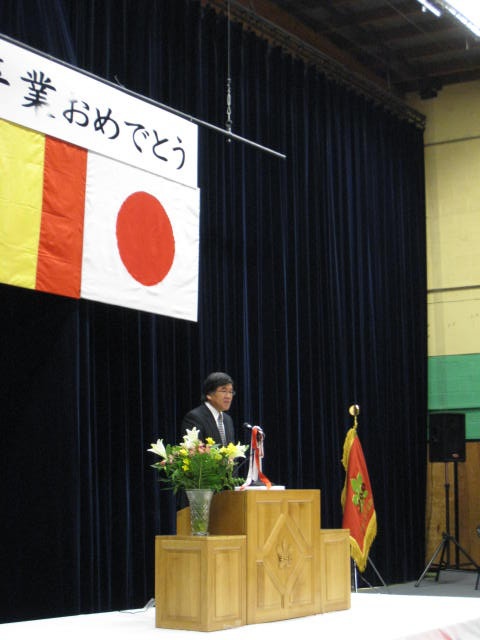 Last month, I attended as a guest the graduation ceremonies of the full-day school and the supplementary Saturday school at the Japanese School. As for the full-day school, it was the elementary school graduation ceremony for 26 pupils of which 16 continue on to the junior high school program and 9 return to Japan to enrol in a junior high school. The supplementary school, on the other hand, held a joint graduation ceremony for 17 pupils of the elementary section and 10 pupils of the junior high section. As a guest, I stressed in my congratulatory speech for the full-day school the “importance of having your own ideas”, and for the supplementary school the fact to “add value to yourself and become a helpful human being”. My talk might have been a little too difficult. At the occasion of the graduation ceremony of the supplementary school, I had the chance to talk with the parents in the common room. They bring their children every Saturday to school by car from regional cities and after dropping them off, the parents wait in the library of the school until the end of the lessons. As the pupils attend two schools by going to the local school, both parents and children go through a great deal of trouble until graduation. Last month, I attended as a guest the graduation ceremonies of the full-day school and the supplementary Saturday school at the Japanese School. As for the full-day school, it was the elementary school graduation ceremony for 26 pupils of which 16 continue on to the junior high school program and 9 return to Japan to enrol in a junior high school. The supplementary school, on the other hand, held a joint graduation ceremony for 17 pupils of the elementary section and 10 pupils of the junior high section. As a guest, I stressed in my congratulatory speech for the full-day school the “importance of having your own ideas”, and for the supplementary school the fact to “add value to yourself and become a helpful human being”. My talk might have been a little too difficult. At the occasion of the graduation ceremony of the supplementary school, I had the chance to talk with the parents in the common room. They bring their children every Saturday to school by car from regional cities and after dropping them off, the parents wait in the library of the school until the end of the lessons. As the pupils attend two schools by going to the local school, both parents and children go through a great deal of trouble until graduation.
In April, it’s the school entrance ceremony. There are 44 pupils in the first grade of the elementary and 19 pupils in the first grade of the junior high for the full-day Japanese school. The number of student’s seems to be almost on a par with previous years. A school entrance ceremony has a fun and exciting atmosphere of something new that’s about to start. In the supplementary school as well, there are 39 first graders in the elementary section and 15 in the junior high section. Of the elementary school children, nearly half of them are international children (children from international marriage) and many of them are boys. Of the junior high school students, 80% are international children and except for 1 boy all of them are girls. Among the first graders in the elementary school, two children will commute to school from Lille in the north of France. The commute takes more or less an hour and a half one-way, so I think the studies are going to be hard for both parents and children.
|